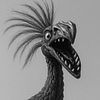Take a photo of a barcode or cover
This book was much better than the one before - I think that writing about romance and interpersonal relationships is Le Guin’s strength. Our narrator is “Farborn,” meaning that he is descended from the people of the League, who sent a ship to this planet (Werel) years ago to reach the native life forms. However, they left because the Great War began, and they have not sent a ship in many years. Knowledge is limited because it is a League tenet to not progress in their life beyond the technology attained by the native peoples. (A fun callback - it seems when Rocannon inherited mindspeech the power was given to all of his descendants, putting the race of Man among alien telepathic races.) The population of Farborn is shrinking, as the planetary conditions force them into sterility. There are positives: they cannot become sick from the planet’s viruses or infected with its bacteria. Our narrator, Jakob Agat, falls in love with a girl of another species - Rolery; they marry. Agat is a natural leader of his people. Their kind band together (some of them, others war) to fight off another species (Gaals) who are driven by bloodlust and migrate South to avoid the cold. When Farborn begin to get sick and infected in battle, Rolery realizes that she perhaps can bear Jakob’s child. The book ends when the brutal race are driven South by a blizzard, leaving a reduced population of the two species living together in a small city.
adventurous
emotional
hopeful
tense
fast-paced
Plot or Character Driven:
Plot
Strong character development:
Complicated
Loveable characters:
Yes
Diverse cast of characters:
Complicated
Flaws of characters a main focus:
No
It was great, I'm really loving all these Hainish books and the way the universe is being built out of sequence. So far I think my order is: Left Hand of Darkness, The Disposessed, Planet of Exile, Rocannon's World.
adventurous
informative
reflective
medium-paced
Plot or Character Driven:
Plot
Strong character development:
Complicated
Loveable characters:
Complicated
Diverse cast of characters:
Complicated
Flaws of characters a main focus:
Yes
This is probably the most action heavy of any book I've read from Le Guin. I think it's interesting that the Farborn have maintained this feeling of exile for over 600 years, only just now beginning to accept this planet as their home. There's interesting commentary here about cultural assimilation, now that they have banded together and share some of the same vulnerability to infections, Huru expects to lose everything about their own culture. Agat and Rolery's love demonstrates this transition the most, and I'd be really interested to know if they ever have kids.
While this is a SciFi book, it still has a fantasy feel to it. While space travel exists, this planet had an embargo on it preventing any up to date technology. Ursula also explores the differences in race by having a love story between essentially two different types of humans. It's a short but very interesting book.
adventurous
dark
emotional
medium-paced
Plot or Character Driven:
Plot
Strong character development:
No
Loveable characters:
No
Diverse cast of characters:
Yes
Flaws of characters a main focus:
No
Planet of exile es el segundo libro de la saga Hainish creada por Úrsula LeGuin y publicado en 1966.
La novela está ambientada en un planeta que sufre glaciaciones periódicas y extremadamente largas que ponen en riesgo el acceso de los habitantes a los alimentos y los recursos naturales básicos para la supervivencia. La historia comienza unos días antes del inicio de una de estas edades de hielo y está contada desde el punto de vista de tres personajes: Rolery, una joven aislada de su tribu por haber nacido en un momento del año cuando no es tradicional hacerlo; Wold, el líder de la tribu y padre de Rolery y Agat, un alien que vive náufrago en el planeta. La tensión incrementa cuando se descubre que, además del inicio de la época fría, este año los personajes tendrán que lidiar con una horda de salvajes norteños violentos, los Gaal, que están emigrando en masa hacia el sur escapando del hielo.
En muchos sentidos, Exile me parece una iteración sobre algunos de los aspectos de Rocanon. Como en la segunda, Exile plantea la interacción de un grupo de alienígenas con un nivel de desarrollo tecnológico sustancial, con nativos incultos. En este caso, LeGuin detalla una solución de no intervención que recuerda a la Prime Directive de star trek, aunque permite la interacción de las culturas avanzadas con los nativos siempre y cuando adapten su nivel de desarrollo a uno equivalente al de los nativos. Lógicamente, como los aliens quedan aislados en el planeta, con el paso del tiempo y el nacimiento de nuevas generaciones, realmente olvidan sus avances tecnológicos, que comienzan a ser semi-legengarios. Como en Rocanon, los PdV iniciales son los de los nativos, que describen la acciones desde su marco tecnológico limitado. Cuando habitamos el PdV de Agat, procede a explicar a qué se referían los nativos utilizando conceptos contemporáneos y más claros. Desgraciadamente, en este caso LeGuin no es capaz de encontrar el equilibrio adecuado entre sugerir los conceptos subyacentes y mantener un ritmo ágil y resulta muy confuso por ello. Al igual que en Rocanon, el libro concluye que la supervivencia sólo es posible cuando la población alienígena se integre con los nativos. Hasta los últimos capítulos se deja claro que los aliens no interactúan con la biosfera: deben de ingerir encimas para poder comer alimentos locales, no pueden tener hijos con los nativos y son inmunes a las enfermedades típicas del planeta porque los virus y las bacterias no pueden interactuar con su fisiología. Convenientemente, en el último capítulo, un personaje se da cuenta de que las heridas de los aliens se infectan y concluye que, la biología local se ha adaptado a la de los aliens y, de alguna manera, ahora podrán tener hijos con los nativos.
Inusualmente para LeGuin, la prosa es bastante confusa, particularmente en las secciones en las que trata de explicar el mundo desde el PdV de los nativos y en las escenas de acción que son sorprendentemente frecuentes para lo que conozco de la autora. Hay algunos puntos que me han resultado llamativos a nivel de wordbuilding, pero no puedo decir que el libro este bien escrito.
En resumen, Exile es un libro normalito sin ningún elemento que lo haga destacar. Si no supiese que los siguientes libros de la saga son excepcionales, dudo que continuase con ella.
La novela está ambientada en un planeta que sufre glaciaciones periódicas y extremadamente largas que ponen en riesgo el acceso de los habitantes a los alimentos y los recursos naturales básicos para la supervivencia. La historia comienza unos días antes del inicio de una de estas edades de hielo y está contada desde el punto de vista de tres personajes: Rolery, una joven aislada de su tribu por haber nacido en un momento del año cuando no es tradicional hacerlo; Wold, el líder de la tribu y padre de Rolery y Agat, un alien que vive náufrago en el planeta. La tensión incrementa cuando se descubre que, además del inicio de la época fría, este año los personajes tendrán que lidiar con una horda de salvajes norteños violentos, los Gaal, que están emigrando en masa hacia el sur escapando del hielo.
En muchos sentidos, Exile me parece una iteración sobre algunos de los aspectos de Rocanon. Como en la segunda, Exile plantea la interacción de un grupo de alienígenas con un nivel de desarrollo tecnológico sustancial, con nativos incultos. En este caso, LeGuin detalla una solución de no intervención que recuerda a la Prime Directive de star trek, aunque permite la interacción de las culturas avanzadas con los nativos siempre y cuando adapten su nivel de desarrollo a uno equivalente al de los nativos. Lógicamente, como los aliens quedan aislados en el planeta, con el paso del tiempo y el nacimiento de nuevas generaciones, realmente olvidan sus avances tecnológicos, que comienzan a ser semi-legengarios. Como en Rocanon, los PdV iniciales son los de los nativos, que describen la acciones desde su marco tecnológico limitado. Cuando habitamos el PdV de Agat, procede a explicar a qué se referían los nativos utilizando conceptos contemporáneos y más claros. Desgraciadamente, en este caso LeGuin no es capaz de encontrar el equilibrio adecuado entre sugerir los conceptos subyacentes y mantener un ritmo ágil y resulta muy confuso por ello. Al igual que en Rocanon, el libro concluye que la supervivencia sólo es posible cuando la población alienígena se integre con los nativos. Hasta los últimos capítulos se deja claro que los aliens no interactúan con la biosfera: deben de ingerir encimas para poder comer alimentos locales, no pueden tener hijos con los nativos y son inmunes a las enfermedades típicas del planeta porque los virus y las bacterias no pueden interactuar con su fisiología. Convenientemente, en el último capítulo, un personaje se da cuenta de que las heridas de los aliens se infectan y concluye que, la biología local se ha adaptado a la de los aliens y, de alguna manera, ahora podrán tener hijos con los nativos.
Inusualmente para LeGuin, la prosa es bastante confusa, particularmente en las secciones en las que trata de explicar el mundo desde el PdV de los nativos y en las escenas de acción que son sorprendentemente frecuentes para lo que conozco de la autora. Hay algunos puntos que me han resultado llamativos a nivel de wordbuilding, pero no puedo decir que el libro este bien escrito.
En resumen, Exile es un libro normalito sin ningún elemento que lo haga destacar. Si no supiese que los siguientes libros de la saga son excepcionales, dudo que continuase con ella.
ششصد سال پیش، سفینهای از لیگ جهانی (حکومتی فراگیر دربرگیرنده صدها سیاره)، به سیارهای در سیستم گاما دراگونیز آمد. سیارهای که هر سال آن، شصت سال زمینی را در برمیگیرد و هر فصل آن پانزده سال به طول میانجامد. مردمان این سفینه، شهرهایی در سیاره ساختند اما بنا بر قانون خود نمیتوانستند از تکنولوژیهای بسیار فراتر از تکنولوژی بومیان سیاره استفاده کنند (برای جلوگیری از نابودی فرهنگ بومیان سیاره). سرنشینان این سفینه قصد داشتند تا مردمان بومی را که همچون قبایل بدوی و کوچنشین زندگی میکردند با تکنولوژیها و دانشهای جدید آشنا کنند و این سیاره را آماده پیوستن به لیگ جهانی کنند. اما پس از تنها چند سال، جنگی بزرگ بین لیگ جهانی و نژادی بیگانه روی میدهد و سفینه ناچار میشود که سیاره را ترک کند؛ با این حال برخی از سرنشینان در سیاره میمانند تا ماموریت خود را تا زمان برگشت دوباره سفینه پیگیری کنند. اما سفینه دیگر برنمیگردد و حال ششصد سال زمینی گذشته و بیست نسل از سرنشینان سفینه در سیاره زندگی کردهاند. نوادگان آنها هنوز خواندن و نوشتن بلدند و کتابهای باقیمانده از گذشتگان خود را میخوانند ولی نمیدانند که سفینه واقعا وجود داشته و یا یک افسانه است! بر اثر شرایط سخت زندگی در سیاره (پانزده سال زمستان سخت در هر سال) و نیز کمشدن هر ساله باروری نوادگان سفینه (که خود را تِواران مینامند)، جمعیت آنها کم شده و تنها چندهزار نفر از آنها در اصلیترین شهرشان، لاندین، باقی ماندهاند.
داستان از ابتدای زمستان دهمین سالگرد حضور سرنشینان سفینه آغاز میشود. هرساله در آغاز فصل زمستان، قبایل مهاجم شمالی بصورت پراکنده برای دزدی به سرزمینهای جنوبی میآیند اما این بار متحد شده و نزدیک به صدهزار نفر در مسیر خود به جنوب تمام شهرهای زمستانی بین راه را چپاول کرده و مردمانشان را میکشند. اکنون، جیکوب آگات آلترا، رییس تراوانها، مجبور میشود برای مقابله با این قبایل، با روسای قبایل ساکن در شهرهای زمستانی اطراف متحد شود. اما ماجرایی باعث برهم خوردن این اتحاد میشود. داستان درباره جنگی است که در ابتدای این زمستان سخت روی میدهد.
داستان از ابتدای زمستان دهمین سالگرد حضور سرنشینان سفینه آغاز میشود. هرساله در آغاز فصل زمستان، قبایل مهاجم شمالی بصورت پراکنده برای دزدی به سرزمینهای جنوبی میآیند اما این بار متحد شده و نزدیک به صدهزار نفر در مسیر خود به جنوب تمام شهرهای زمستانی بین راه را چپاول کرده و مردمانشان را میکشند. اکنون، جیکوب آگات آلترا، رییس تراوانها، مجبور میشود برای مقابله با این قبایل، با روسای قبایل ساکن در شهرهای زمستانی اطراف متحد شود. اما ماجرایی باعث برهم خوردن این اتحاد میشود. داستان درباره جنگی است که در ابتدای این زمستان سخت روی میدهد.
The idea of a world in which seasons are 15 Earth-years long is developed really well. There's some fairly generic low-tech society politics and head smashing as the main plot. I enjoyed the typically intense-but-clinical Le Guin romance that propels the later part of the story but found the world-building to be the only gem.
adventurous
tense
medium-paced
Plot or Character Driven:
Plot
Strong character development:
No
Loveable characters:
No
Diverse cast of characters:
Complicated
Flaws of characters a main focus:
Yes
challenging
emotional
reflective
medium-paced
Plot or Character Driven:
Character
Strong character development:
Yes
Loveable characters:
Yes
Diverse cast of characters:
Yes
Flaws of characters a main focus:
Yes






